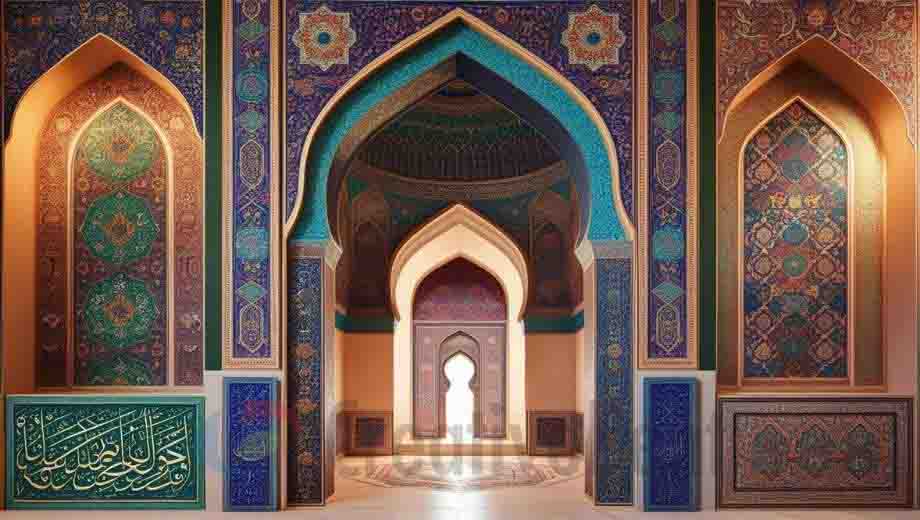
Islamic art spans a wide range of artistic expressions and is a vibrant and expanding field. This art style is a profound expression of the historical, cultural, and spiritual history of the Islamic world and includes everything from exquisite architectural designs to fine calligraphy and vibrant pottery. Exploring Islamic art enables us to discover the splendor of the religion, as well as its profound spirituality and age-old traditions.
The Islamic Art Form as a Whole
Islam places a strong emphasis on reverence for the divine. The elaborate patterns, harmonic compositions, and symbolic themes that characterize Islamic art are manifestations of this regard. The Islamic appreciation of unity, infinity, and the natural world is reflected in the use of geometric and vegetal patterns, known as arabesques.
The art of the written word is calligraphy
The importance of the written word in Islam gives calligraphy a distinct place in Islamic art Verse from the Quran, Hadith, and poetry are all written in Arabic script, which is characterized by its graceful curves and flowing lines. This kind of artwork is frequently found adorning mosques, castles, and commonplace items, transforming them into objects for meditative spiritual meditation.
Architecture: A Divine Manifestation
The magnificent beauty and minute detail of Islamic architecture are well known. In addition to being places of worship or dwelling, mosques, mausoleums, castles, and fortresses serve as spiritual monuments that demonstrate the presence of the divine. Domes, minarets, arches, and courtyards are notable features that have both aesthetic and practical uses.
Islamic Textiles and Ceramics: A Colorful Kaleidoscope
Islamic fabrics and ceramics are prized for their elaborate patterns and vivid colors. These works of art display the exceptional skill and aesthetic ingenuity of Islamic artists, from the beautiful glaze of Iznik ceramics to the intricate designs of Persian carpets.
Jewelry and Metalwork: Creating Beauty
Islamic metalwork and jewelry exhibit extraordinary skill and creativity. Objects like bowls, ewers, and jewelry items frequently have calligraphy, figurative artwork, and complex geometric designs on them. Additionally, these things gain dimension and texture through engraving and inlaying processes.
Storytelling Through Illumination and Miniature Painting
In the Islamic world, illumination and miniature painting were essential components of manuscript culture. Miniature paintings depicting scenes from literature, history, and daily life gave a window into the society of the time, while illuminations graced Quranic manuscripts with gold and brilliant colors.
Influence of Islamic Art
Islamic architecture has had a major influence on art and architecture throughout the world. Reflecting the widespread influence of Islamic civilization, its principles and designs may be seen in Europe, Africa, and Asia.
Modern Islamic Art: A Conversation with Tradition
Modern themes and techniques are incorporated, yet traditional components are still used as inspiration by contemporary Islamic artists. Thought-provoking works that examine identity, spirituality, and cultural legacy are produced as a result of this blending of the ancient and contemporary.
Islamic Culture Through the Preservation of Islamic Art
Maintaining a connection to the cultural and spiritual history of the Islamic world depends on the preservation of Islamic art Museums, educational institutions, and restoration initiatives play an important role in this endeavor, ensuring that future generations can enjoy and benefit from these great masterpieces.
Every brushstroke, geometric design, and architectural marvel in the enthralling realm of Islamic art is imbued with a profound feeling of spirituality and cultural depth. Google searches for “Discovering Islamic Art” reveal a widespread curiosity for the rich symbolism and complex beauty ingrained in this enduring legacy. By investigating Islamic art, we not only see the beauty of the past but also the lasting influence of a cultural legacy that enthralls and inspires people worldwide.





I do agree with all the ideas you have introduced on your post They are very convincing and will definitely work Still the posts are very short for newbies May just you please prolong them a little from subsequent time Thank you for the post
Thanks for sharing. I read many of your blog posts, cool, your blog is very good.